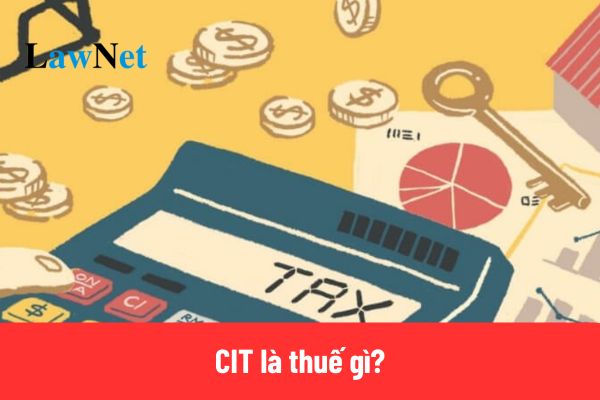What is CIT in Vietnam? How to determine the 2025 CIT tax period in Vietnam?
What is CIT?
CIT stands for Corporate Income Tax, which refers to the corporate income tax as detailed in the Corporate Income Tax Law 2008. This is a direct tax levied on the taxable income of enterprises after reasonable and legitimate expenses have been deducted according to legal regulations.
To clarify the question of what CIT is, below are some of the main characteristics of CIT for your reference:
(1) What is CIT? Is it a direct tax or an indirect tax?
CIT is a direct tax, levied directly on the taxable income of the enterprise after deducting reasonable and legitimate expenses.
The business entity is the taxpayer and also the tax bearer, and this tax liability cannot be transferred to another party, unlike value-added tax (VAT).
(2) Based on the income of enterprises:
- CIT is calculated on the total taxable income of the enterprise, including income from production and business activities and other incomes after deducting reasonable and legitimate expenses and other deductions according to legal regulations.
- The tax base is the taxable income of the enterprise as stipulated in Article 3 of the Corporate Income Tax Law 2008, including:
- Profit from main production and business activities.
- Income from financial activities (interest on deposits, investment in securities...).
- Income from the transfer of assets, real estate, intellectual property rights...
(3) Adjustments according to economic policy:
- The CIT rate may be preferential or reduced to encourage investment in priority development sectors, fields, or locations as stipulated in Articles 13 and 14 of the Corporate Income Tax Law 2008, which regulate tax rate incentives and tax exemption and reduction duration for investment projects in areas with particularly difficult socio-economic conditions, economic zones, high-tech areas, and other prioritized fields.
(4) Method of declaration and payment of tax:
Enterprises must declare CIT quarterly and pay taxes on a provisional basis. At the end of the year, the enterprise must finalize taxes and pay additional taxes or receive a refund if applicable.
(5) Types of taxable income:
- Income from production, business activities of goods, and services.
- Income from the transfer of capital, transfer of land use rights.
- Other income from legal activities of enterprises.
(6) Tax rates:
- The standard tax rate for enterprise income is 20% (according to current regulations) and may change over time and by type of enterprise. Additionally, the tax rates include:
- Preferential tax rates: 10%, 15% (applied to high-tech sectors, high-tech agriculture, economic zones...).
- Especially high tax rates: 32% - 50% (applied to enterprises exploiting resources, petroleum...).
- Some enterprises may be eligible for preferential tax rates depending on specific conditions, such as investment in prioritized sectors, fields, or special economic zones.
(7) Loss deduction mechanism:
Article 16 of the Corporate Income Tax Law 2008 stipulates that enterprises with losses can carry forward losses to subsequent years and offset them against taxable income.
The loss carryforward period should not exceed 5 years from the year immediately following the year of loss occurrence.
(8) Direct impact on enterprise profits:
CIT reduces the net profits of enterprises; hence, enterprises need to optimize costs and apply tax incentives to minimize the tax payable.

What is CIT in Vietnam? (Image from the Internet)
How to determine the 2025 CIT tax period in Vietnam?
According to the provisions of Article 5 of the Corporate Income Tax Law 2008, it is stipulated as follows:
Tax Period
1. The corporate income tax period is determined according to the calendar year or fiscal year, except for cases stipulated in Clause 2 of this Article.
2. The corporate income tax period based on each occurrence of income applies to foreign enterprises as stipulated at points c and d, Clause 2 of Article 2 of this Law.
Thus, the CIT tax period is determined as follows:
- Determined according to the calendar year or fiscal year
- Determined on each income occurrence for foreign enterprises, as follows:
- Foreign enterprises with permanent establishments in Vietnam pay taxes on taxable income arising in Vietnam that is unrelated to the activities of the permanent establishment;
- Foreign enterprises without a permanent establishment in Vietnam pay taxes on taxable income arising in Vietnam.
When is the time for determine the turnover for calculating taxable income in Vietnam?
Based on Clause 2, Article 5 of Circular 78/2014/TT-BTC (amended and supplemented by Article 3 of Circular 96/2015/TT-BTC), the time for recognizing revenue to calculate taxable income is determined as follows:
- For sales activities, it is the time of transferring ownership or the right to use the goods to the buyer.
- For service provision activities, it is the time of completing the service provision or completing each part of the service provision to the buyer, except for the cases mentioned in Clause 3, Article 5 of Circular 78/2014/TT-BTC, Clause 1, Article 6 of Circular 119/2014/TT-BTC.
- For air transportation activities, it is the time of completing the transportation service provision to the buyer.
- Other cases according to legal regulations.

